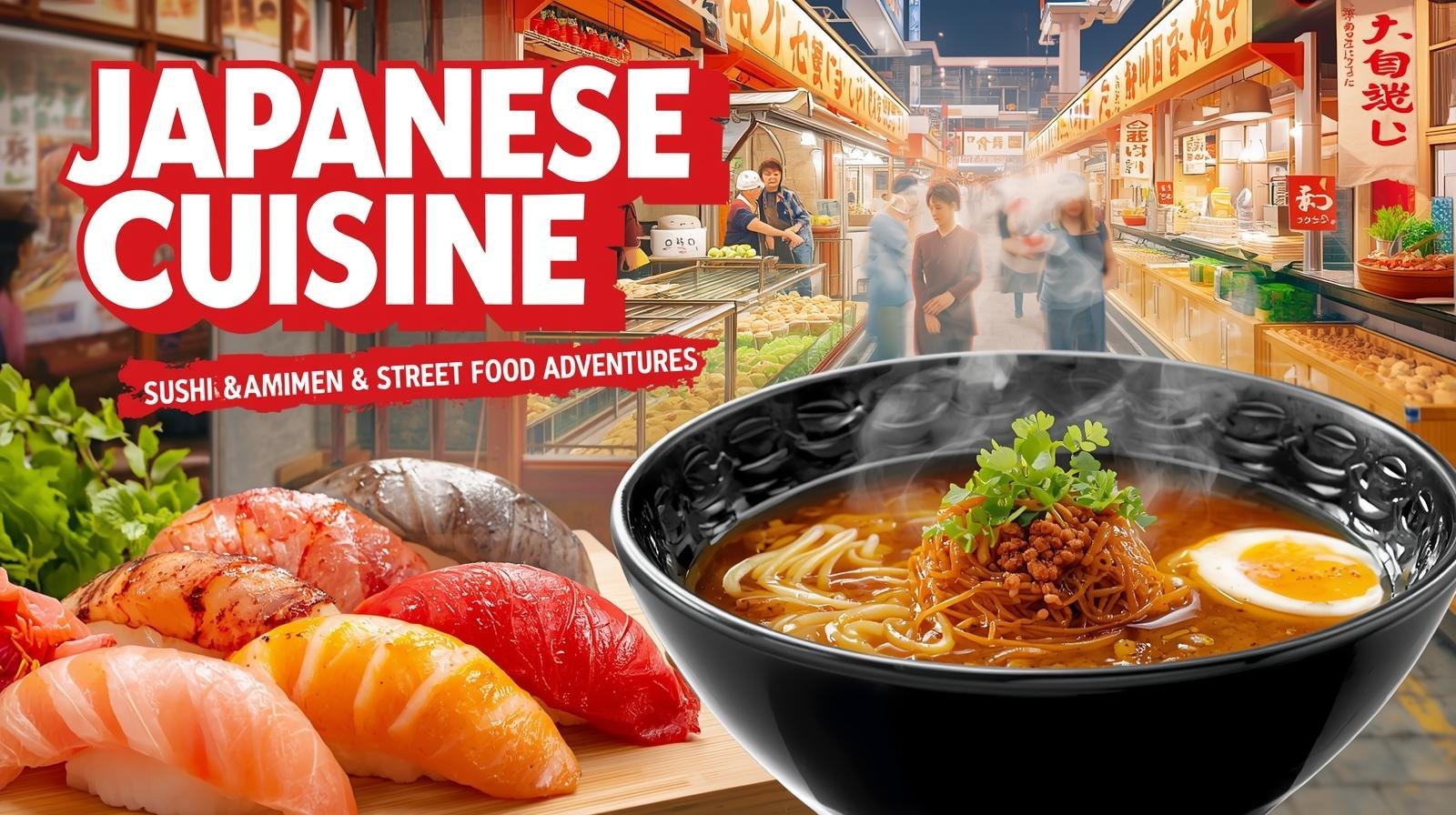Japanese cuisine is far more than just a way to satisfy hunger; it is a rich journey through flavors, traditions, and culture. Each dish tells a story, from delicate sushi rolls crafted with precision to steaming bowls of flavorful ramen that warm the soul, and vibrant street food that captures Japan’s lively culinary spirit. Exploring Japanese food offers something for every taste, whether you are a seasoned food enthusiast or someone new to traditional Japanese dishes. Searching for “Japanese food near me” can uncover authentic dining experiences, from cozy sushi restaurants to bustling ramen shops and lively street food markets.
This guide will introduce you to must-try dishes, share tips for enjoying them, and highlight where to experience the best of Japanese cuisine, making every bite a memorable adventure.
Introduction to Japanese Cuisine
When people think of Japanese cuisine, sushi and ramen are usually the first things that come to mind. But Japanese food culture is rich and diverse, offering much more than what appears on the surface. The cuisine emphasizes seasonality, freshness, and presentation, making it as visually appealing as it is delicious. Whether it’s a fine dining sushi restaurant or a bustling street food stall, each bite tells a story of history, creativity, and passion. Tips for Winning Scholarships in Japan
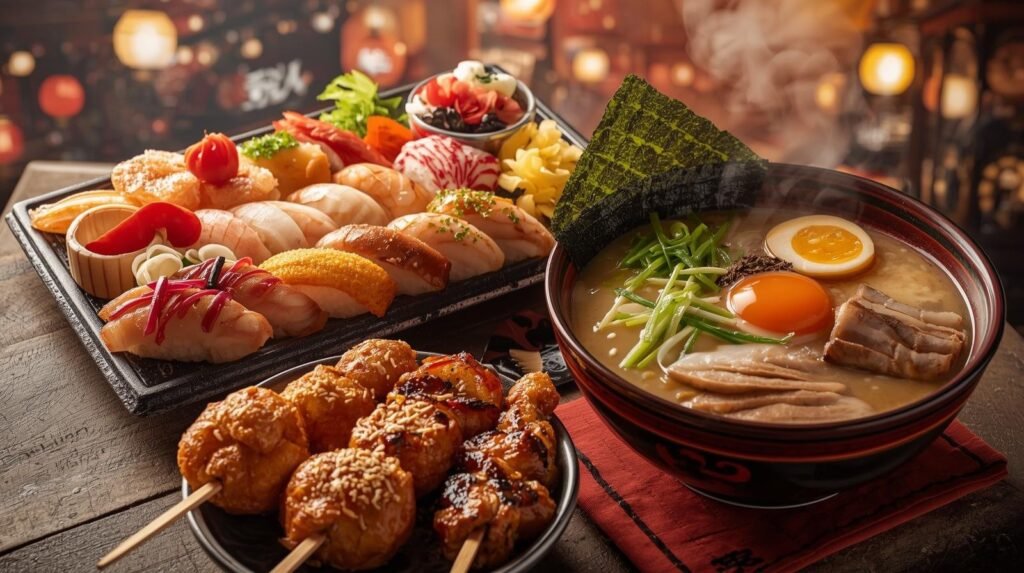
Japanese cuisine is not just about taste—it’s about an experience. Dining in Japan is often a cultural journey, with traditions and rituals accompanying meals. From the meticulous preparation of sushi to enjoying a steaming bowl of ramen on a rainy day, the experience is immersive.
Sushi: The Art of Japanese Culinary Mastery
Sushi is perhaps the most iconic element of Japanese cuisine. It involves carefully prepared vinegared rice combined with fresh fish, vegetables, and sometimes tropical fruits. Sushi has become a global favorite, but tasting it in Japan offers an entirely different experience. Japanese Scholarship Application Process
Types of Sushi
Nigiri, maki, sashimi, and inari sushi are popular types, each showcasing unique flavors and presentation styles.
- Nigiri: Hand-pressed rice topped with fresh fish or seafood.
- Maki: Rolled sushi wrapped in seaweed with rice and fillings inside.
- Sashimi: Thin slices of raw fish served without rice.
- Inari Sushi: Rice stuffed in sweet tofu pockets, often vegetarian-friendly.
Tips for Enjoying Sushi in Japan
Try conveyor belt sushi, visit traditional bars, and experience omakase for fresh, authentic Japanese sushi flavors. Scholarships for International Students in Japan
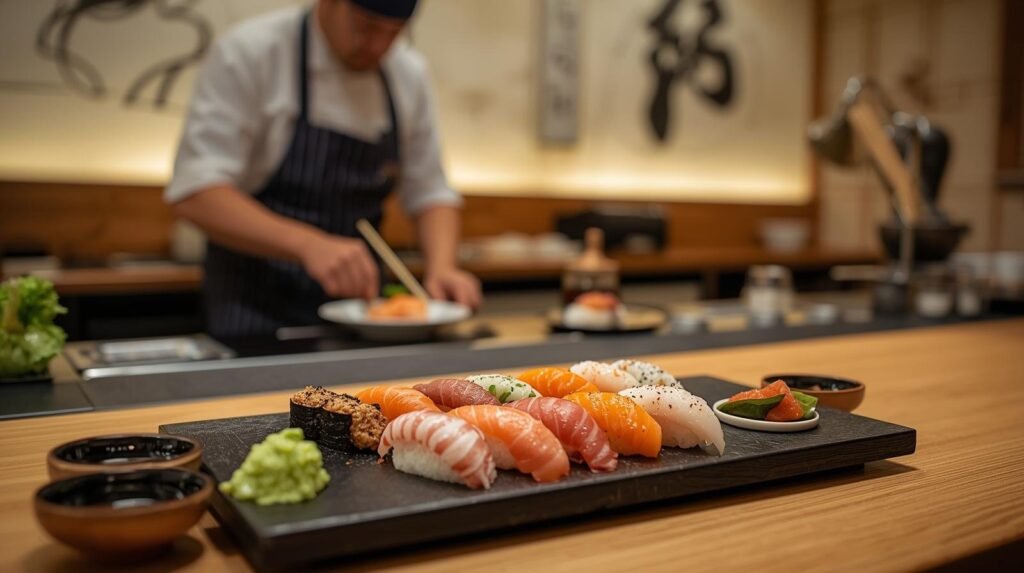
- Visit traditional sushi bars or try omakase, where the chef selects seasonal ingredients for you.
- Conveyor belt sushi (kaiten-zushi) is fun, casual, and perfect for trying different varieties quickly.
- Always use soy sauce and wasabi sparingly to savor the delicate flavors.
Sushi Recipes You Can Try at Home
Even if you can’t travel to Japan right now, making sushi at home can be a rewarding experience. Basic sushi recipes use ingredients like nori sheets, sushi rice, fresh vegetables, and seafood. It’s a fun way to bring Japanese culinary experiences into your own kitchen. University-Specific Scholarships in Japan
Ramen: A Steaming Bowl of Comfort
Ramen is a staple of Japanese cuisine, beloved for its rich flavors, hearty broths, and satisfying noodles. Every region in Japan has its unique style of ramen, making it an exciting dish to explore.
Popular Types of Ramen
Shoyu, miso, tonkotsu, and shio are popular types of ramen, each offering unique broths, flavors, and regional Japanese culinary experiences.
- Shoyu Ramen: Soy sauce-based broth, light and savory.
- Miso Ramen: Fermented soybean paste adds a deep, nutty flavor.
- Tonkotsu Ramen: Creamy pork bone broth, rich and filling.
- Shio Ramen: Salt-based, clear and subtle in taste.
Best Ramen in Japan
Cities like Tokyo, Sapporo, and Fukuoka are famous for their ramen. Tokyo offers a wide variety of styles, Sapporo is known for miso ramen, and Fukuoka is home to tonkotsu ramen. Visiting local ramen restaurants is an excellent way to immerse yourself in Japanese food culture.
Tips for Enjoying Ramen
Slurp noodles to enjoy flavors, try regional varieties, pair with gyoza or edamame, choose busy local shops for freshness, and savor broth slowly for authentic ramen experience. Government Scholarships for Studying in Japan
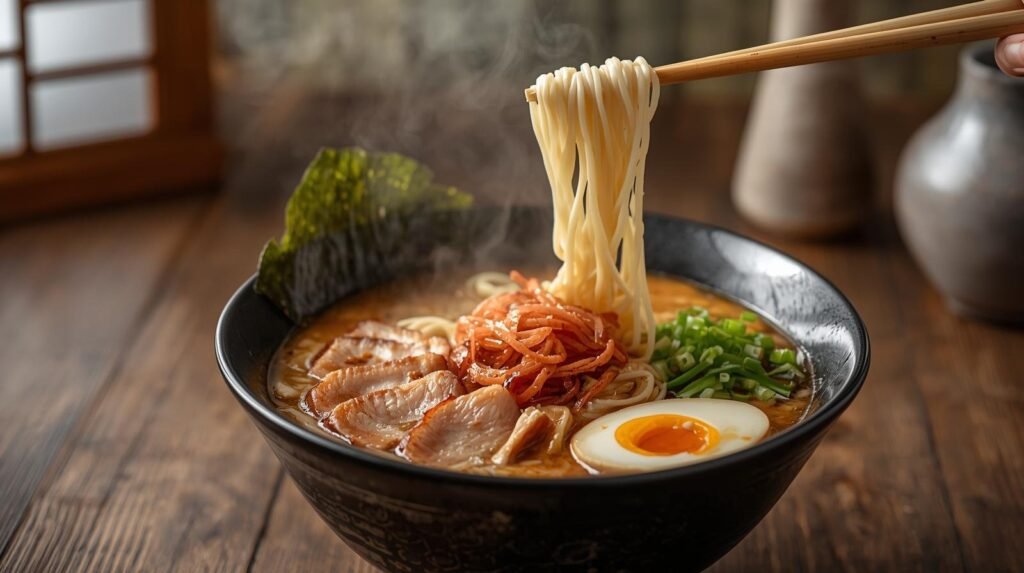
- Slurping is encouraged! It’s a sign that you are enjoying the meal.
- Try regional specialties to taste authentic flavors.
- Pair your ramen with Japanese snacks like gyoza or edamame for a complete meal.
Japanese Street Food: Flavorful Adventures
Japanese street food is an adventure for your taste buds. Unlike fast food, Japanese street food emphasizes quality, freshness, and flavor.
Must-Try Japanese Street Foods
Takoyaki, taiyaki, yakitori, okonomiyaki, and mochi are must-try Japanese street foods, offering flavorful, fun, and authentic culinary experiences.
- Takoyaki: Octopus balls served with savory sauce and bonito flakes.
- Taiyaki: Fish-shaped cakes filled with sweet red bean paste.
- Yakitori: Grilled chicken skewers, seasoned with salt or sauce.
- Okonomiyaki: Savory pancakes with vegetables, meat, or seafood.
- Mochi: Sweet sticky rice treats, often with fillings like red bean paste.
Street food stalls are often bustling, providing a lively atmosphere that reflects Japan’s energetic urban life. For tourists, street food is also affordable, with most items costing between ¥200–¥800 ($1.50–$6). Scholarship Opportunities in Japan
Traditional Japanese Dishes Beyond Sushi and Ramen
While sushi and ramen dominate international attention, traditional Japanese dishes are diverse and flavorful.
- Tempura: Lightly battered and fried vegetables or seafood.
- Sukiyaki: Hot pot dish with thinly sliced beef, vegetables, and tofu.
- Kaiseki: Multi-course meal emphasizing seasonal ingredients.
- Onigiri: Rice balls filled with pickled plums, salmon, or tuna.
These dishes offer a deeper insight into Japanese food culture and highlight the balance of taste, nutrition, and aesthetics.
Japanese Food Near Me: Finding Authentic Experiences
For food lovers seeking Japanese cuisine locally, many cities now offer authentic sushi restaurants, ramen restaurants, and Japanese culinary experiences. Searching “Japanese food near me” can lead to delightful surprises—from casual sushi bars to high-end Japanese dining. Always check reviews and authenticity, and look for restaurants run by Japanese chefs for the most genuine experience. Tokyo Experiences 2025
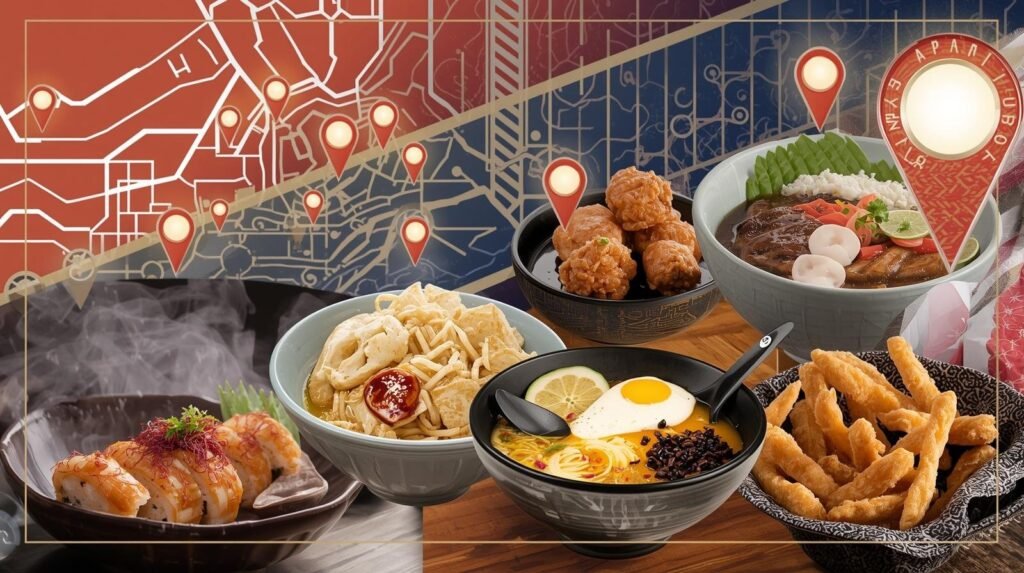
Japanese Snacks: Perfect Bites Anytime
Japanese cuisine also excels in snacks, offering both sweet and savory options:
- Senbei: Crispy rice crackers, sometimes flavored with soy sauce.
- Pocky: Biscuit sticks coated in chocolate or matcha.
- Dorayaki: Pancakes filled with red bean paste.
These snacks reflect Japan’s attention to detail and creativity in food. They are perfect for travel, gifting, or even just enjoying a taste of Japanese culture at home.
Japanese Culinary Experiences: More Than Just Food
Japanese cuisine is an immersive experience. Beyond tasting, there’s the art of preparation and presentation. Participating in sushi-making workshops, visiting ramen shops, or joining street food tours can enhance your appreciation of Japanese food culture. Culinary experiences also provide a glimpse into the traditions, etiquette, and philosophy behind each dish. Best Time to Visit Japan in 2025

Health Benefits of Japanese Cuisine
One reason Japanese cuisine is celebrated worldwide is its health benefits. Many dishes are balanced with rice, vegetables, and fish, using low-fat cooking methods such as steaming or grilling. This focus on fresh, natural ingredients contributes to longevity and overall wellness.
Vegetarian options are also widely available, including dishes like vegetable tempura, inari sushi, and miso soup.
Drinks to Pair with Japanese Cuisine
To complement your Japanese meals, traditional drinks like sake, green tea, Japanese beer, and plum wine are excellent choices. Each drink enhances the flavors of sushi, ramen, or street food, making the dining experience more enjoyable. Best Time to Visit Japan in 2025
FAQs About Japanese Cuisine
Q1: What are the most popular Japanese dishes?
Japanese cuisine is known for its variety and balance, and some dishes have become iconic worldwide. Sushi, with its delicate combination of vinegared rice and fresh fish, is a classic favorite. Ramen, a hearty noodle soup with flavorful broths, is loved for its warmth and versatility. Tempura, which consists of lightly battered and fried vegetables or seafood, offers a crisp texture. Street favorites like takoyaki (octopus balls), okonomiyaki (savory pancakes), and yakitori (grilled chicken skewers) are also widely popular, showcasing both traditional and regional flavors of Japan.
Q2: What is the difference between sushi and sashimi?
While both are essential elements of Japanese cuisine, sushi and sashimi are distinct. Sushi combines vinegared rice with fresh fish, seafood, or vegetables, often presented as rolls or hand-pressed portions. Sashimi, on the other hand, is purely thinly sliced raw fish served without rice. The focus in sashimi is on the quality and freshness of the fish, making it a favorite for purists who want to savor the natural flavor of seafood.
Q3: Where can I find authentic ramen in Japan?
Japan’s ramen scene is diverse, with each region offering unique styles and flavors. Tokyo is known for shoyu (soy sauce) ramen, offering a light yet savory broth. Sapporo, in Hokkaido, specializes in rich miso ramen, often topped with corn and butter for added flavor. Fukuoka is famous for tonkotsu ramen, a creamy pork-bone broth that is deeply satisfying. Visiting local ramen restaurants in these cities provides an authentic taste of Japanese culinary culture.
Q4: What are must-try Japanese street foods?
Japanese street food is a vibrant part of the culture and perfect for food adventurers. Takoyaki, small octopus-filled dough balls topped with sauces and bonito flakes, are a crowd favorite. Taiyaki, fish-shaped cakes filled with sweet fillings like red bean paste, is fun and tasty. Yakitori skewers, okonomiyaki savory pancakes, and mochi rice cakes are also highly recommended. Street foods are not only delicious but also reflect Japan’s creativity and local flavors.
Q5: Is Japanese cuisine healthy?
Yes, Japanese cuisine is widely regarded as healthy due to its balance of rice, vegetables, fish, and lean proteins. Cooking methods like steaming, grilling, and light frying preserve nutrients while keeping dishes low in fat. Meals often include fresh ingredients, seasonal vegetables, and minimal use of heavy sauces, contributing to a diet that is both flavorful and nutritious.
Q6: Can I eat Japanese street food as a tourist safely?
Absolutely. Street food in Japan is generally very hygienic and carefully prepared. Vendors prioritize cleanliness and use fresh ingredients. For the best experience, choose busy stalls where locals eat, as this ensures the food turnover is high and fresh. Following simple precautions, like observing preparation practices, will make enjoying Japanese street food safe and enjoyable.
Q7: What is the best way to enjoy sushi in Japan?
Sushi can be enjoyed in multiple ways depending on the setting. Conveyor belt sushi (kaiten-zushi) offers a casual and fun experience where you can pick plates as they move past. Traditional sushi bars provide a more intimate dining experience with sushi chefs preparing each piece in front of you. Omakase, meaning “I leave it up to the chef,” allows chefs to select seasonal and fresh ingredients, offering a curated tasting experience for those seeking the best sushi experience in Japan.
Q8: Are there vegetarian options in Japanese cuisine?
Yes, Japanese cuisine caters to vegetarians with a variety of dishes. Vegetable tempura, inari sushi (rice stuffed in sweet tofu pockets), and miso soup are excellent vegetarian-friendly options. Many restaurants also offer dishes featuring tofu, mushrooms, and seasonal vegetables, making it easy for vegetarians to enjoy authentic Japanese flavors.
Q9: How much does Japanese street food cost?
Japanese street food is affordable and accessible. Most items are priced between ¥200–¥800 (approximately $1.50–$6), depending on the dish and location. Takoyaki, taiyaki, and small skewers fall within this range, allowing tourists and locals to sample multiple dishes without spending much. The cost-effectiveness makes Japanese street food ideal for casual snacking or a culinary adventure on a budget.
Q10: What drinks pair well with Japanese cuisine?
The right drinks can enhance the Japanese dining experience. Sake, a traditional rice wine, complements sushi and sashimi beautifully. Green tea is commonly enjoyed with meals and aids digestion. Japanese beer pairs well with grilled dishes like yakitori, while plum wine offers a sweet contrast to savory flavors. Each beverage enhances the taste and enjoyment of Japanese cuisine, creating a well-rounded meal experience.
Conclusion
Japanese cuisine offers a perfect balance of taste, tradition, and cultural richness. From sushi recipes and ramen restaurants to vibrant Japanese street food, every dish is an experience waiting to be savored. Whether you are exploring Japanese food near me or planning your next culinary adventure in Japan, the journey through Japanese cuisine promises unforgettable flavors and memories. Kyoto Traditional Japan
Ready to dive deeper into Japanese culture and language to enhance your culinary travels? Connect with TLS – The Japanese Language School for authentic Japanese learning experiences. Call us at +91 8700956038 to start your journey today!

